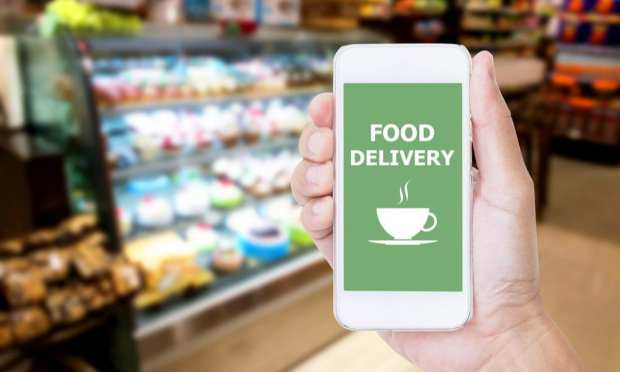Delivering QSR Ordering Options With Digital Collaborations

Quick-service restaurants are teaming with online platforms to let diners receive their favorite menu items via delivery. Krispy Kreme, in one case, plans to roll out nationwide delivery on Feb. 29 per news on Monday (Feb. 24), and on-demand delivery platform DoorDash will send doughnuts by the dozen in addition to boxed coffee. A delivery fee of $4.99 will apply for most shops.
Krispy Kreme is hardly the only quick-service restaurant (QSR) that has joined forces with a digital platform for delivery. According to the PYMNTS Order-To-Eat Tracker, “Fast casual restaurants often turn to aggregators to expand their delivery reach — for good reason.” The report pointed out that DoorDash handled 35 percent of all meal deliveries in the United States last year, while Grubhub wasn’t too far behind at 30 percent.
But not every restaurant is encouraging diners to turn to third-party delivery aggregators. Many reasons inform the reluctance of QSRs to rely on them, such as delivery fees and diners becoming loyal to the service rather than to them. As a result, some restaurants have their own digital ordering platforms.
From Little Caesars to Yelp, quick-service restaurants and technology providers alike are working to make it easier for diners to place their orders — and for eateries to reach those customers. Here’s just a few examples of how these companies, among others, are innovating with digital ordering:
The portion of consumers who use mobile phones for at least part of their QSR experience is 70 percent. Starbucks, for example, saw its mix of mobile order and pay transactions in the U.S. increase to 17 percent in the first quarter. Starbucks President and CEO Kevin Johnson said on a conference call with analysts in January that its “industry-leading digital platform will further differentiate us from the competition over time.” Johnson also noted that the company added a record 1.4 million customers to its 90-day active Starbucks Rewards member base. It finished out the quarter with 18.9 million active U.S. members, which indicated a 16 percent year-over-year rise. Johnson also noted that the coffee chain knows from experience that when customers join its rewards program, “their total spend with Starbucks increases meaningfully.”
The approximate portion of the U.S. meal delivery market DoorDash controlled in October 2019 was 35 percent. And Little Caesars Enterprises Inc. plans to team with DoorDash to supply pizza delivery services from 3,600 restaurants in the United States and Canada. Little Caesars is said to be the third-biggest pizza chain in the world. The quick-service pizza restaurant chain will not make diners have minimum purchases to receive deals and will not restrict discounts to carry-out orders. Products will be priced the same for delivery and takeout, and the full menu will be available for delivery. Orders, for their part, will come via Little Caesars’ website and mobile app. The restaurant chain will not be listed on the DoorDash platform as a participating restaurant. DoorDash will cover roughly 90 percent of Little Caesars’ Canada and U.S. locations.
The share of consumers who have at least one QSR app on their phones is 57 percent. In one case, Dunkin’ opened up its digital ecosystem by allowing any consumer to use its on-the-go mobile ordering, which was exclusive to DD Perks members in the past. The feature lets any diner — not just Perks members — make an order and earn points through their preferred payment method. The company processed more than 20 million on-the-go orders in Q4, which Dunkin’ Brands CEO Dave Hoffmann said in a recent call with analysts is “a new milestone for us.” Dunkin’ Brands, for its part, brought on 146 net new Dunkin’ and Baskin-Robbins locations around the globe in the fourth quarter, with the inclusion of 76 net new Dunkin’ locations domestically.
The segment of consumers who would be more likely to repeat a QSR visit if they received ads based on their past orders is 70 percent. And, in other ad news, new ad products introduced by Yelp will allow restaurants to better understand the effect of their ads on local foot traffic. The Yelp Store Visits service is mainly designed for businesses that have multiple stores. It will examine first-party attribution and work to find out cost per visit that diners are spending by tapping into opt-in location information. According to Yelp per reports, a company that participated in a pilot for the program achieved a cost per visit of $1.17 through Yelp ads. Showcase Ads, another offering, enables national brands to highlight new menu items, seasonal offers and temporary promotions.
The share of restaurants that offer ordering capabilities directly in their apps is 18 percent. Bandit, in one instance, serves diners via a mobile order only café in New York City. Customers download the company’s app prior to making their orders, which are then sent to the company’s café. There is a pickup counter for their orders when diners arrive at the café. They can remain in the space if they choose, but consumers are taking their orders for the most part and continuing on with their days. Bandit Co-Founder and CEO Max Crowley told PYMNTS in a past interview that the company homes in on “the digital ordering experience and the physical handoff.” And, even though Crowley noted that the cafe has excellent java, it also provides other options via the app beyond cold brew or black coffee.
From Bandit to Yelp and DoorDash, quick-service restaurants and digital platforms are aiming to make better restaurant ordering experiences from the perspective of consumers as well as businesses. And, heading into the future, focusing on delivery is likely to provide restaurants with clout among younger consumers, as half of U.S. millennials order delivery more often than they did just two years before compared to one-third of adults as a whole.
